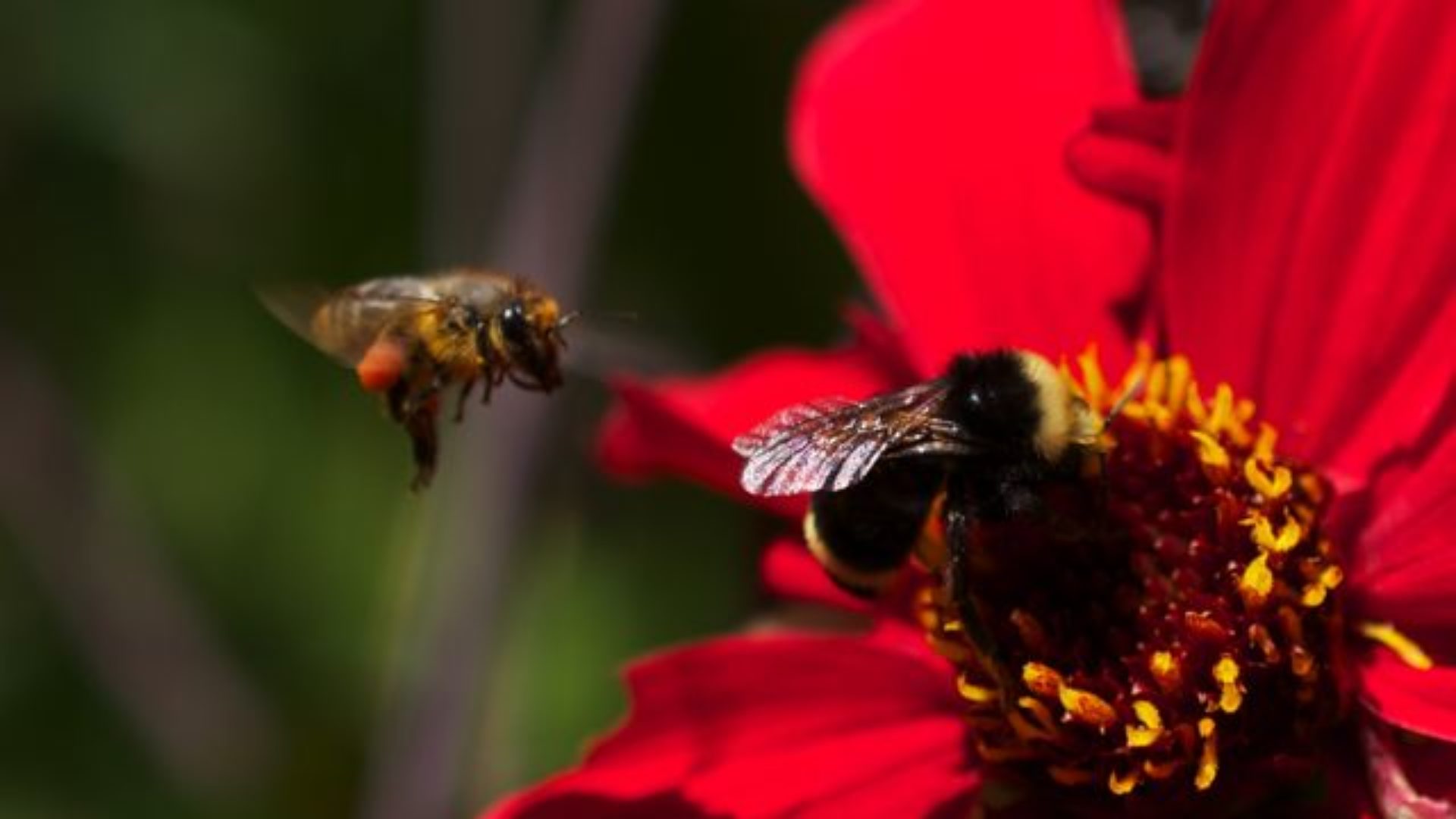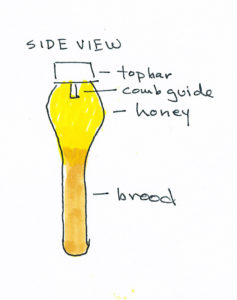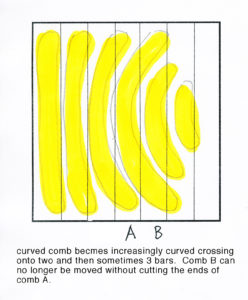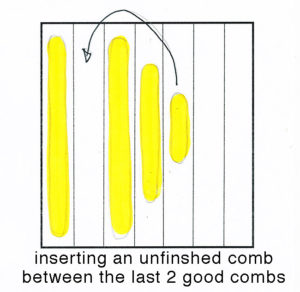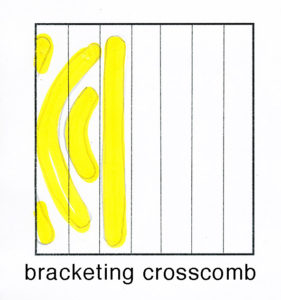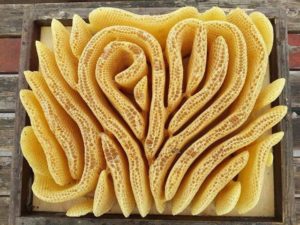

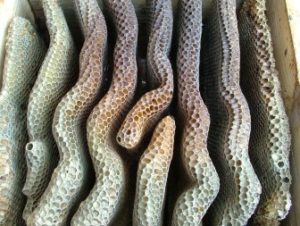
ELEGANT ARCHITECTURE
To understand cross comb you must first understand the concept of “bee space.” Bee space is the regular amount of space that bees leave between their combs in order to move freely through the hive. Beespace is always the same within the hive. It may vary slightly from hive to hive depending on the size of the bee (honeybees raised on imprinted foundation tend to be larger than feral bees who have reverted to a natural smaller size after a few generations and thus their beespace is also narrower by a few millimeters). But no matter what shape they are building, the next comb will be built maintaining the regular amount of beespace for that colony. Thus the combs fit together like puzzle pieces or “spoons.” For the bees this regular amount of space means efficiency in heating and cooling the hive, as well as in fanning and evaporation of the honey.
Another factor is comb width. Generally speaking brood comb is slightly narrower than honeycomb. In a feral hive brood comb is built out first at the top and then is widened for honey as the colony builds downward in the space. Beespace is a bit narrower in the honey area, as this is longterm storage—just as our own long term storage doesn’t need to be quite as accessible, so it is with the bees. In the horizontal top bar hive we notice that the honey stores above the brood on each brood comb is thicker than in the brood area…often bulging and occasionally tearing as we pull out the combs. In the back end of the top bar hive we will see combs built altogether wider for honey storage. The result is that our comb in the back end will tend to get off center of our bars.
The other thing that can happen in the honey area is that the bees start to curve the edges of the comb—usually towards the back. Honeycomb is quite heavy and a curved architecture is stronger…the curve functionally makes a triangle, which is the strongest architectural form. But once a small curvature is in the comb, with each new comb built the curve deepens so that soon the edges of this comb are built onto the bar next to it. Once this happens of course we beekeepers can no longer easily move our top bars, in order to do so, we’d have to cut the side attachments of bar A in order to move Bar B (see diagram). If this were the lighter brood comb we might get away with this, but with heavy honey comb this leaves bar A with less than ½ of the comb attached to a bar and it often falls and collapses, creating bee massacre and honey mess.
This type of cross comb occurring in the honey area is relatively easy to prevent and repair if it is caught early, I will talk about that later in the article.
The other kind of cross comb is when the bees, for whatever reason built a comb that cuts diagonally or perpendicularly across two or more bars. Why they do this is somewhat mysterious, but my observation is that it often has to do with heat and speed. On cool days the bees build slowly and regularly…I don’t see much cross comb here in the coastal East Bay. But when it is hot the bees build fast and furious. I also have seen them turn a corner to avoid the side of the hive that is hot from the sun. And of course once they build one comb that doesn’t follow our guide bar, any comb built after that maintains beespace, so they will continue to build across two or more bars once they have started on this path.
PREVENTION & REPAIR
Cross comb is no problem for the bees, it is only an issue for the beekeeper who wants to be able to move her bars (or frames in a foundationless Langstroth Hive) and observe her bees. There exist many styles of beekeeping where the bees are not managed or just minimally managed—such as the Warre system and the bees do just fine. The only reason you might want to be able to manage all the way to the front end of your hive is if you want to take a split in the Spring. Depending on the amount of cross comb you have, you may be able to remove at least a portion of it during honey harvest or in the Fall or early spring when the population is low. We’ll get to this soon.
The best method of controlling cross comb is prevention and the only way to prevent it is to manage your hive more often during this quick build out. It seems to me this happens in new colonies after the first big round of brood has hatched, during the hot part of the early summer when there is still abundant floral resources and there is a big push to build comb to accommodate an even larger round of brood and the coming honey flow.
During this time (and any other time the bees are building) we can induce the bees to build straight by introducing a blank bar or a partially built paddle of comb in between the last two fully built straight combs. Generally speaking except in the case of bracketing (see below) or spring swarm prevention we never want to put empty space in the brood area, as this makes it difficult for the bees to maintain the constant temperature needed for brood.
Any time the comb starts to curve at the back end this should be corrected, by detaching the curved edges from the bar minimally and pushing them back in line with the comb guide. The bulging sides can also be trimmed or sliced if needed. This can be further controlled by bringing the last perfectly straight bar all the way to the back behind the bar that is starting to curve.
If the bees start to build diagonally or perpendicular to the bars in the brood area this should be corrected ASAP. Once they have built out 2-3 bars in this manner, there is no way to correct this without destroying the comb, killing lots of workers and risking killing your queen. The good news is that for the functionality and health of the hive it doesn’t matter that these bars are no longer moveable. As long as you can verify that you have a good laying queen there is no reason to manage your hive all the way to the front during the summer season. Later you will be able to start to remove the wonky comb once the population is low.
If you do find cross comb or curved comb in your hive, you can still insert a blank or partially built bar between the last two straight ones, but you will also need to prevent more cross comb from being built by containing it by a straight comb. I call this bracketing. This is where it is useful to have two hives of the same dimension or a friend with a hive of the same dimension to pull straight comb from. If you do not have a hive to pull from, you can try pulling a straight bar of comb from elsewhere in your hive if you know that they did build straight at some point. This can be tricky as it requires pulling a bar straight up without moving any other bars, but it can be done.
video: Pulling a straight comb from the front end of the hive to bracket wonky crossed comb.
In order to identify the extent of your cross combing you can use your tool to separate the bars by about ¼ inch on one side. Here you will be able to see where the comb is crossing each bar and what the pattern is, without breaking the comb. Open this space between each bar on one side until you find your straight comb. Count or mark the bars with cross comb in some way so you know where it is. Carve or cut the last bar of cross comb that was built, so that a flat comb can fit next to it and place your flat comb behind it (on the side towards the back end of your hive). If there is partially built comb that is not yet crossed or wonky you can put this behind the flat bar (on the side towards the back end of your hive)., but if it is wonky at all it should be bracketed between two flat bars.
Go back into your hive within 7 days to see that they are now building straight.
Now you have identified where you cross comb is and hopefully the bees are now building straight at the back end of the hive. With luck they will fill this straight comb with honey, as well as filling some of the cross comb with honey. Later in the season when the population has downsized we can start to remove some of the cross comb.
At honey harvest in early Fall we can start by moving any straight bars of honey out of the way. Then we’ll harvest as much of the cross comb as we can…moving towards the front until we find brood. Once it is clear that we will damage brood comb and potentially our queen, we are done harvesting cross comb. Then we move those good bars of honey towards the front end next to the brood area and leave them as winter stores.
If there is a sunny day in late winter, we can again go into the hive and manage and remove any cross comb we can without impacting the brood area. At this point the comb will also be aged and polished with propolis so it will be more sturdy. It may be possible at this point to break apart some of the cross comb and save straight portions of brood comb by attaching them to clean empty bars with rubberbands. Important is that we don’t create too much space in the brood area when it is still cold and rainy.
Examples of open air, natural comb hives which show how beespace occurs naturally
